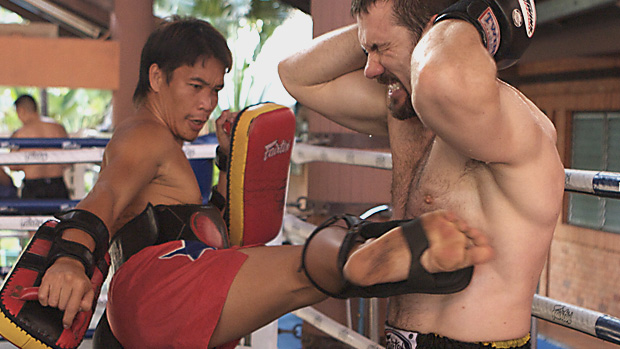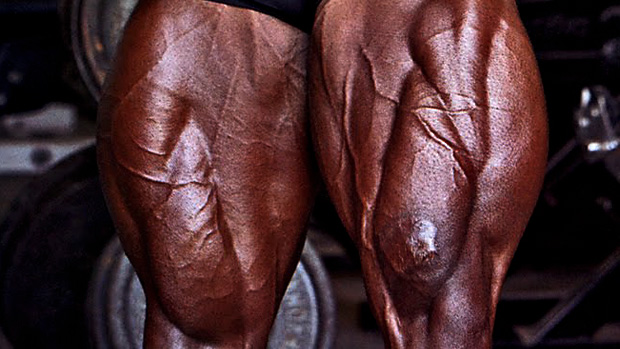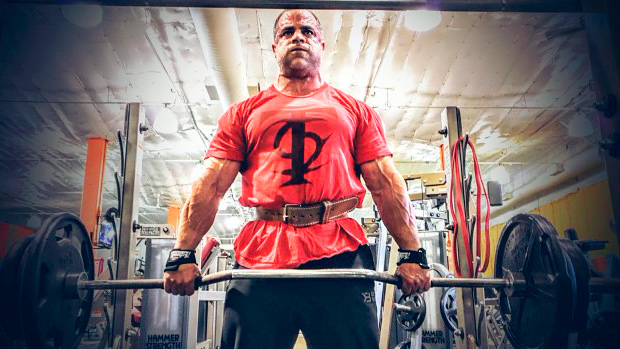Some things are just unacceptable, like dating your third cousin, reaching for the big piece of chicken when you didn't even cook the thing, or not knowing about Martin Rooney, Renaissance man.
A world-class strength and speed coach, Rooney has more credentials and letters after his name than I can list. But he's not just one of those "academic" types; he gets his hands dirty.
A former member of the US Bobsled Team, one of the top NFL-combine preparation coaches, and consultant with the world-class Renzo Gracie jiu-jistsu team (he trains with them, too), Rooney likes to be in the action just as much as he likes to study it.
That's why when he told me he just returned from a two-year stint of traveling, learning, and training with some of the world's elite athletes for a new book he was writing, I knew it was time to introduce him to the T NATION readers.
T Nation: Two years in traveling through Holland, Japan, Thailand, Russia, Brazil, and the States, huh? What were you looking for?
Perspective.
Everyone knows that sushi in Wisconsin isn't the same as in Japan. And the acai berry shit they sell in the US as the cure-all miracle elixir is vastly different than actual fresh acai berries. Things are often better when you get to the source, and I wanted to see if that held true for training.
Like, if you want to learn how to use kettlebells, how cool would it be to go to Russia and learn from the best? If you want to learn cool bodyweight exercises for combat, why not go to Japan where Judo was invented? If you want to learn how to make your body a suit of armor, why not got to Thailand, get kicked in the stomach a few thousand times, and learn some new abdominal exercises?
What I found in all these countries over the past two years is this: there's a lot less conservatism and a lot more creativity as it relates to training. Most of these places didn't have the luxury of the beautiful gyms and all the equipment we have here in the US, but they do have something most of us lack: hardcore work ethic.
I'm also a proponent of the idea that you've got to try everything and see what you like before you subscribe to anything people try to ram down your throat. And until you've been kicked in the rib cage or taken a straight shot in the gut and feel your organs bash into the back of your thorax, you don't get to talk about it or teach other people how to be in "fighter shape."
It was a liberating experience and gave me more understanding of how the body should be prepared and trained. There are some people who sit behind a keyboard and talk a big game, but I didn't want to put myself out there until I spent some time actually putting the work in.
T Nation: I like it. But why am I talking to you? I don't mean that in a bad way, either. Here at TMSUCLE we're interested in making our muscles bigger and stronger to look good and perform better. What can guys interested in their physiques learn from combat athletes?
It's a good question. Due to the popularity of the martial arts and UFC, people are using "fighter" methods to get stronger, leaner, and more powerful, even if they don't want to get punched in the face.
For one thing, combat guys know how to get a ripped physique. They put in more training sessions per week, at higher rates of intensity, and since they want to be as massive as possible at the smallest weight, they really work at their nutrition.
Plus, the bodyweight conditioning exercises these guys use can help you develop technical strength, power, and just get you in badass shape.
I'm of the philosophy that you can learn anything from anybody and apply it to your own situation.
T Nation: Fair enough. What do you mean by technical strength?
I think there are a few different kinds of strength, two of them being technical and angular. Here's what I mean. When I was in Japan I stayed at a top Judo Univeristy and lived with the athletes.
Now, I could crush these guys in the gym. I could squat and bench more and jump higher. But as soon as they put their hands on me in Judo practice, I knew I was in trouble. It's like they turned into a silverback gorilla. These guys can just roll you into a pretzel because they know how to use their muscle mass in a coordinated, controlled way. I just wasn't there yet because I didn't have the technique and didn't know how to get my body to work as a whole.
So bodyweight strength training was the best way I found to build those qualities. And they didn't just do regular ol' pushups, either. They had upwards of fifty different kinds of push-ups and even used crazy creative partner drills. They were hanging off each other, doing reverse-hypers and crunches.
I started doing partner drills and more bodyweight exercises with my athletes when I got back home, and some interesting stuff happened. We got more hypertrophy. We went back to the bench press and everyone got stronger. We got leaner.
No one talks about this stuff because it seems too "simple." But it works. And everyone feels better. Out of my two years I never saw anyone with rotator cuff injuries or any of the other crap that plagues most guys in the gym.
T Nation: So how would someone like me add bodyweight moves into my training? Just replace a workout day with some bodyweight stuff?
You don't have to replace anything, Nate. Just incorporate it. For example, last Monday was an upper-body workout for my UFC guys. But before our main workout we do a warm-up, and our warm-up looks like a freakin' workout.
We'd run a sprint and then do twenty push-ups. But not just regular pushups. We'd do crazy ones, ten and ten of each. Then we'd do forty sit-ups. And we did that five times, for a total of 100 pushups and 200 sit-ups before we even do our regular workout.
There was a new UFC dude training with us that day and he couldn't even get through the warm-up.
T Nation: But wouldn't all that bodyweight training be detrimental to the weight workout?
It depends on what your goals are. I bet most guys reading this want to be more powerful and muscular and want to look better; they want the full look-like-a-warrior package. For them, it's perfect.
If you've got a powerlifter or a guy who's only goal is to step on stage, then sure, I don't think it's the greatest idea. But like I said earlier, I'm seeing hypertrophy in my guys. When they get to the actual weight training, they're able to use more weight for more reps after incorporating some bodyweight stuff. And they're burning more fat and getting leaner at the same time.
T Nation: Cool. Care to share a push-up you learned?
Sure. Get in a regular push-up position. Lower yourself while keeping your elbows to your sides and your abs tight.
When you press back up, kick one leg up to the opposite hand. Return the leg back to the original position and repeat on the opposite arm and leg. It's hard as hell.
T Nation: Let's talk about some of the specific countries. Do Russians really have a love obsession with kettlebells?

The only cult following is the one here. We all know the experts who use only kettlebells and claim it's all you ever need. Well, I wanted to investigate and what I found was interesting. In Russia, the kettlebell is definitely used, but it's still just a tool. It's not a fad or a new-wave type of thing. They use barbells and dumbbells and their own bodyweight, too.
Another thing: these guys aren't using wussy weights. The guys I trained with were tossing 70-pound kettlebells ten feet over their head. It was amazing to watch. There were no light kettlebells in any of the gyms, either, definitely nothing less than 70 pounds.
But the most interesting thing was how they were doing a lot of traditional moves like overhead presses, rows, curls, and even lateral flys with them. It seems like people here are trying to get too fancy and aren't using enough weight to put muscle on or build power.
But I guess you don't learn that from a 1500-dollar two-day kettlebell course, huh?
T Nation: Guess not. A lot of trainers and lifters get a hard-on when they talk about the Eastern Bloc methods and all the science behind it. What did you find out?
It's funny because a lot of it wasn't scientific or in a lab. It was just hardcore, old-school lifting with big weights. And these were some historic gyms, like Dynamo sports era, Lenin-approved facilities.
Are the Eastern guys precise? Sure. But people can take an idea and turn it into legend. Once you go, you realize it's been sensationalized.
T Nation: Was it hard getting over some of your own prejudices? You told me earlier you did some long-distance running and thousands of crunches.
Yeah, but I quickly adapted. I told myself I was going to do everything the guys I was training with did.
Let's take the idea of abdominal training. Yeah, six-packs are cool, but the guys in Thailand and Holland talked about "building body armor." They trained abs in the morning, during their regular kickboxing sessions, and in the evening. They'd stand there and kick each other 200 times on each side of the stomach and then do a few hundred crunches. They were tempering their body to take some heavy shots.
And guess what? They all had six-packs.
It's just funny how quickly we shun different ideas once someone reads a study, interprets it the way they want and scares the piss out of the entire country. Just look at fitness in the States: sit-ups turned to crunches turned to planks turned to stand there and hold your breath and don't do anything.
But the results these kickboxers got were undeniable and I didn't see any lower back problems or neck problems.
I felt like I was challenging current conventional wisdom, the black and white mentality of training. We have to understand that we don't get to say what's right or what's wrong for everybody. We're all individuals and respond to different training.
T Nation: What's the craziest thing that happened to you during your travels?
I went to a Russian Banya, which is a huge bathhouse where you lay there naked while people beat you with wet, hot branches covered in aromatic oils that are supposed to help you recover. The branches get so hot that they're scalding your ass. Then they chase you outside and make you dive in to a frozen pond of water. You gotta try that at least once.
We were also pulled over at gunpoint in two countries and were in an all-out Karaoke competition in Japan. You have no idea how crazy it is until you see how seriously the Japanese take their karaoke. They'll bust out Beyonce in perfect English but then can't say a damn word to you after.
T Nation: You told me earlier you picked up some great advice from the Russians. What was it? Something about vodka?
"Always be a little hungry."
They were always hungry to train and learn more, but they were also just plain hungry for food. When they ate, they wouldn't fill their plates. They felt it was best to always be craving.
I think it's pretty damn smart. I think we evolved to always be a little hungry. It probably helps us think and react more quickly than the guy who pounds his food and has to sit down before he passes out.
Something else I learned: there are a lot of people working a hell of a lot harder than you could ever imagine, whether you go to Thailand and they're doing three sessions a day in 100-degree heat or head to Japan where they do eight hours of Judo per day. It opened my eyes to another level of capacity to what the human body can endure.
When you move with the guys who've devoted their lives to training you realize you have no business standing there with them. I imagine it's like standing on stage next to Jay Cutler if you were a recreational bodybuilder.
In the end, I got the shit kicked out of me for this book, but I wanted to make something I was proud of. But I mainly wanted to show what else is out there. We're all prisoners of our own thoughts, and the most important anatomy you can have is an open mind.
T Nation: Excellent point. Thanks for the interview, Martin!





